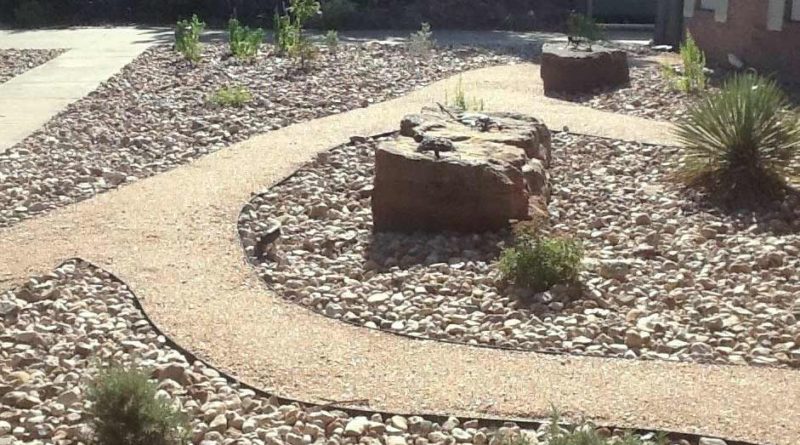Drought-free design: Consider xeriscaping for a landscape with staying power
While drought conditions continue in Central Texas, finding affordable ways to beautify your lawn and garden is challenging. Xeriscaping, a form of landscaping that reduces or eliminates the need for extra water, just might be the solution to keeping the greenery without going broke paying exorbitant water bills.
Jessica Robertson, biologist and owner of Backbone Valley Nursery in Marble Falls, said misconceptions abound when the term xeriscaping comes up. “A lot of people, when they think of xeriscaping, think of a cactus or a rock garden,” she said, pointing out that there is much more to the concept.
Persistent drought conditions are the primary reason that xeriscaping is so ubiquitous lately. “It’s becoming more popular in Texas because of the water restrictions … because of the drought that we’ve had,” Robertson said.
Drought conditions began in October 2010 and reached a peak in 2011. A state impact report by NPR states that 2011 was the driest year ever for Texas, with an average of only 14.8 inches of rain. “By no means is the drought over,” Robertson said. “We got some relieving rains in 2014, but we are still nowhere back out of being considered in extreme drought,” she said.
Xeriscaping encompasses a number of principles. “One is that it all leads to saving water, so planning and design is really big,” added Robertson. Other aspects of xeriscaping include thoughtful plant selection, using a frugal but efficient irrigation system and choosing to put in more practical turf areas.
“People put in these beautiful landscapes and they … spend all this money to put a fancy irrigation system in, then they can’t even use it,” she said.
Grass selection is also an important consideration, because certain grasses require more water than others. “St. Augustine grass is the biggest water hog you can plant,” Robertson said. “It requires a lot of water to keep it looking pretty.”
There are more practical, less expensive grass options actually native to Central Texas. “Bermuda, Zoysia and Buffalo are all good drought-tolerant grasses for this area,” said Robertson.
Choosing native plants is an essential part of xeriscaping because they will eventually need less water. “Here at the nursery we’ve seen a huge trend toward more drought-tolerant plants,” she said.
Robertson cautioned, however, that the plants need to establish their root systems first before their maintenance becomes minimal. “Until those roots grow and spread … at that point you can back off the water,” she said. She added that mulching will not only control weeds, but will also help retain plant moisture longer.
Ben Pamplin, president of Heart of Texas Landscape and Irrigation in Belton, echoed Robertson’s opinion about xeriscaping stereotypes, saying rock gardens are often what people think of. Besides not being terribly attractive, he said rock gardens just radiate heat in the summer.
Thankfully, this is by no means the only option when it comes to conserving water. “You can integrate decomposed granite beds and reduce the amount of sod in your yard,” Pamplin said, adding that native plants are an easy way to create a low-maintenance look that is easy on the eyes.
“There are just a ton of different options to provide color with native plants,” he said. “Most of them are perennials — they die out in the winter and they come back every spring and do really well here.”
Pamplin pointed to the Grand Avenue Theater in Belton as a good example of xeriscaping because it features drip irrigation under the sod, decomposed granite and perennial plants. “A lot of the municipalities are moving this way,” he said.
Grass can still be part of a lawn, he said, but should be planted strategically, and ideally not underneath trees. “When you plant trees, don’t put sod underneath,” Pamplin said. “No matter what kind of grass you have, it needs so many hours of sunlight.”
In his own yard, he uses mulch and decomposed granite or river rock under the trees, then adds shade-tolerant flowers.
Proper grouping of plants is also part of the xeriscaping philosophy. Pamplin said he often sees people putting the wrong plants next to each other. For example, Knockout Roses, which are hardy and drought-tolerant, shouldn’t be planted alongside plants that need a lot of water. “What happens is the roses end up getting fungus on them because they’re getting watered too much, and then they decline,” he said.
Irrigation, not surprisingly, is crucial. “To have proper xeriscaping … if you have the opportunity, do it from the ground up,” Pamplin said. “If you have a landscape design, the irrigation design needs to coincide.”
Some native plants and trees both Robertson and Pamplin recommend for Central Texas include desert willow, red yucca, Texas mountain laurel, salvia, lansier, and cedar shade. Pamplin also likes spineless cactus, which is needle-free. “You can still have a really nice xeriscaped yard that’s beautiful and accomplish all your goals without making it just a straight desert look,” he said. “If you’re a do-it-yourself kind of person, you can do that stuff on your own and you’ll have colorful plants that are attractive.”



